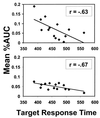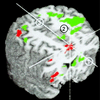Right hemispheric dominance of inhibitory control: an event-related functional MRI study - PubMed (original) (raw)
Right hemispheric dominance of inhibitory control: an event-related functional MRI study
H Garavan et al. Proc Natl Acad Sci U S A. 1999.
Abstract
Normal human behavior and cognition are reliant on a person's ability to inhibit inappropriate thoughts, impulses, and actions. The temporal and spatial advantages of event-related functional MRI (fMRI) were exploited to identify cortical regions that showed a transient change in fMRI signal after the withholding of a prepotent motor response. The temporal specificity of the event-related fMRI design also minimized possible contamination from response inhibition errors (i. e., commission errors) and other extraneous processes. Regions identified were strongly lateralized to the right hemisphere and included the middle and inferior frontal gyri, frontal limbic area, anterior insula, and inferior parietal lobe. Contrary to the prominence traditionally given to ventral frontal regions for response inhibition, the results suggest that response inhibition is accomplished by a distributed cortical network.
Figures
Figure 1
Response-inhibition task. This schematic representation of the task indicates that subjects responded, with alternation, to the target letters X and Y, and withheld response on nonalternating presentations of these target letters. Letters were presented for 500 msec in black against a white background with 0-msec interstimulus interval.
Figure 2
ER–fMRI time-series analysis. Example of an average fMRI time series, time-locked to correct response inhibitions, taken from a voxel in the dorsolateral prefrontal cortex of one subject. The averaged data are represented by ■ and the best-fitting γ-variate function is represented by the smooth line. The portion of the curve before departure from baseline was fitted with a flat line. Departure points were constrained to occur within 4 sec of the lure presentation. The scaling parameter, k, was free to vary, whereas the exponential parameters were constrained as follows: 8 ≤ r ≤ 9, 0.15 ≤ b ≤ 0.45. To provide a measure of the response magnitude, the area under the curve was expressed as a percentage of the area under the baseline, determined by the linear portion of the fitted model and its continuation (shown as a dashed line).
Figure 3
Response inhibition activation. Significant right hemisphere activation during response inhibition is shown on one subject’s anatomy. Areas shown include the inferior frontal gyrus (1), middle frontal gyrus (2), insula (3), and inferior parietal lobule (4). The axial slice is 41 mm anterior to the anterior commissure, and the anatomy has been made slightly transparent to reveal the activation that lies just below the cortical surface.
Figure 4
Correlation between mean response time (msec) to targets and the mean activation within the right inferior frontal cluster (Upper) and the left inferior parietal lobule cluster (Lower).
Figure 5
Functional activation associated with response inhibition for lures (red) and response executions for targets (green) are displayed on one subject’s anatomy. Responding to target letters produced activation in striatal (1), primary motor, premotor, SMA proper (2), and bilateral parietal regions (3). Also shown in red is the pre-SMA activation observed during response inhibition. The coronal slice is 16 mm anterior and the axial slice is 46 mm superior to the anterior commissure.
Similar articles
- Handedness-dependent functional organizational patterns within the bilateral vestibular cortical network revealed by fMRI connectivity based parcellation.
Kirsch V, Boegle R, Keeser D, Kierig E, Ertl-Wagner B, Brandt T, Dieterich M. Kirsch V, et al. Neuroimage. 2018 Sep;178:224-237. doi: 10.1016/j.neuroimage.2018.05.018. Epub 2018 May 19. Neuroimage. 2018. PMID: 29787866 - Hemispheric asymmetries in the transition from action preparation to execution.
Sulpizio V, Lucci G, Berchicci M, Galati G, Pitzalis S, Di Russo F. Sulpizio V, et al. Neuroimage. 2017 Mar 1;148:390-402. doi: 10.1016/j.neuroimage.2017.01.009. Epub 2017 Jan 6. Neuroimage. 2017. PMID: 28069542 - Word rhyming as a probe of hemispheric language dominance with functional magnetic resonance imaging.
Kareken DA, Lowe M, Chen SH, Lurito J, Mathews V. Kareken DA, et al. Neuropsychiatry Neuropsychol Behav Neurol. 2000 Oct;13(4):264-70. Neuropsychiatry Neuropsychol Behav Neurol. 2000. PMID: 11186162 Clinical Trial. - Large-scale functional neural network correlates of response inhibition: an fMRI meta-analysis.
Zhang R, Geng X, Lee TMC. Zhang R, et al. Brain Struct Funct. 2017 Dec;222(9):3973-3990. doi: 10.1007/s00429-017-1443-x. Epub 2017 May 27. Brain Struct Funct. 2017. PMID: 28551777 Free PMC article. Review. - Executive functions in obsessive-compulsive disorder: An activation likelihood estimate meta-analysis of fMRI studies.
Del Casale A, Rapinesi C, Kotzalidis GD, De Rossi P, Curto M, Janiri D, Criscuolo S, Alessi MC, Ferri VR, De Giorgi R, Sani G, Ferracuti S, Girardi P, Brugnoli R. Del Casale A, et al. World J Biol Psychiatry. 2016 Aug;17(5):378-93. doi: 10.3109/15622975.2015.1102323. Epub 2015 Dec 7. World J Biol Psychiatry. 2016. PMID: 26642972 Review.
Cited by
- Uncinate fasciculus fractional anisotropy correlates with typical use of reappraisal in women but not men.
Zuurbier LA, Nikolova YS, Åhs F, Hariri AR. Zuurbier LA, et al. Emotion. 2013 Jun;13(3):385-390. doi: 10.1037/a0031163. Epub 2013 Feb 11. Emotion. 2013. PMID: 23398586 Free PMC article. - Multiple modes of clearing one's mind of current thoughts: overlapping and distinct neural systems.
Banich MT, Mackiewicz Seghete KL, Depue BE, Burgess GC. Banich MT, et al. Neuropsychologia. 2015 Mar;69:105-17. doi: 10.1016/j.neuropsychologia.2015.01.039. Epub 2015 Jan 28. Neuropsychologia. 2015. PMID: 25637772 Free PMC article. - Analysis of Altered Baseline Brain Activity in Drug-Naive Adult Patients with Social Anxiety Disorder Using Resting-State Functional MRI.
Qiu C, Feng Y, Meng Y, Liao W, Huang X, Lui S, Zhu C, Chen H, Gong Q, Zhang W. Qiu C, et al. Psychiatry Investig. 2015 Jul;12(3):372-80. doi: 10.4306/pi.2015.12.3.372. Epub 2015 Jan 20. Psychiatry Investig. 2015. PMID: 26207132 Free PMC article. - In search of a human self-regulation system.
Kelley WM, Wagner DD, Heatherton TF. Kelley WM, et al. Annu Rev Neurosci. 2015 Jul 8;38:389-411. doi: 10.1146/annurev-neuro-071013-014243. Epub 2015 Apr 30. Annu Rev Neurosci. 2015. PMID: 25938728 Free PMC article. Review. - Efficiency of go/no-go task performance implemented in the left hemisphere.
Hirose S, Chikazoe J, Watanabe T, Jimura K, Kunimatsu A, Abe O, Ohtomo K, Miyashita Y, Konishi S. Hirose S, et al. J Neurosci. 2012 Jun 27;32(26):9059-65. doi: 10.1523/JNEUROSCI.0540-12.2012. J Neurosci. 2012. PMID: 22745505 Free PMC article.
References
- Barkley R A. Psychol Bull. 1997;121:65–94. - PubMed
- Peterson B S, Skudlarski P, Anderson A W, Zhang H, Gatenby J C, Lacadie C M, Leckman J F, Gore J C. Arch Gen Psychiatry. 1998;55:326–333. - PubMed
- Enright S J, Beech A R. Br J Clin Psychiatry. 1993;32:67–74. - PubMed
- Shulman K I. J Affective Disord. 1997;46:175–182. - PubMed
- Dempster F N, Brainerd C J, editors. Interference and Inhibition in Cognition. San Diego: Academic; 1995.
Publication types
MeSH terms
Grants and funding
- DA09465/DA/NIDA NIH HHS/United States
- M01 RR000058/RR/NCRR NIH HHS/United States
- DA10214/DA/NIDA NIH HHS/United States
- RR-00058/RR/NCRR NIH HHS/United States
- R01 DA009465/DA/NIDA NIH HHS/United States
- R01 DA010214/DA/NIDA NIH HHS/United States
LinkOut - more resources
Full Text Sources




